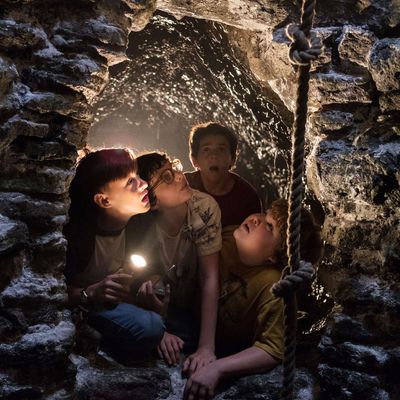
I’ll admit that I’ve spent most of my life not really “getting” It. I never read Stephen King’s novel, mostly because I couldn’t understand what all the fuss was about. A killer clown seemed like a rather arbitrary monster-of-the-week creation, and his apparent ability to shape-shift only made the concept more arbitrary. The 1990 TV mini-series adaptation didn’t do much to clear things up for those hoping to skip the 1,200-plus pages of reading. It’s a flat, plodding regurgitation of the story, and the degree to which it had to tiptoe around some of the story’s more troubling themes and scenes of violence (for the sake of broadcasting regulations) rendered the epic weirdly insubstantial; a coming-of-age story with some scary scenes thrown in.
So the new adaptation, directed by Andy Muschietti (2013’s Mama), is in that rare category of remakes that actually have a mission — to do more justice to the source material, to just be a better movie in general. (If all remakes were this kind of remake, people like me wouldn’t complain about them nearly as much — I’d rather see directors try to improve upon unsuccessful past works than try to re-create classics.) And on that count at least, it succeeds: This new It has more on its mind, and gives more body and voice to King’s ideas of childhood anxieties and the corrosive power of fear. It’s also a good deal more scary, and not just because its R rating allows it to show little Georgie Denbrough flailing around with a missing arm in its rendition of It’s first attack.
The film opts to only take on the childhood half of King’s story, and time jumps it to the late ’80s instead of the 1950s, presumably so the expected volume two can take place in our present day. It takes place in the small town of Derry, Maine, and centers on a group of seven young outcast teens known as the “Losers’ Club.” After Bill’s (Jaeden Lieberher) little brother George (Jackson Robert Scott) disappears amid a spate of missing children cases, Bill and the rest of the club begin having terrifying visions that all culminate in an encounter with Pennywise, the Dancing Clown — a malevolent face-painted creature with glowing yellow eyes and multiple sets of jaws. As they begin to put the pieces together, it leads them to a centuries-old curse on the town, and the understanding that the monster that haunts them has the ability to embody their worst fears and prey upon them.
The script, which still credits previously slated director Cary Fukunaga among its writers, is smart enough to allow plenty of room for the squirrelly obscenities of youth to rattle around. We have to believe in these kids enough that we take their individual fears seriously, and Muschietti, along with his pretty impeccably cast ensemble, mostly pulls it off. There’s more development and depth here — and more laughs as well — than there was for any of their 1990 counterparts. Stranger Things’ Finn Wolfhard as foul-mouthed smart aleck Richie is a particular standout; he’s an incredibly recognizable knot of insecurity and wit that doesn’t always know the best time for a joke. Sophia Lillis as Beverly is also a bright, empathetic screen presence, a tomboyish girl from the wrong side of town with a troubled home life who seems to be clinging to her own youthful innocence even as it’s pulled away from her.
The trick of the film, and as I understand it, the reason the book is as long as it is, is that it develops the group dynamic of the Losers’ Club in tandem with each individual’s inner life and cornucopia of anxieties. That’s TV-series-level complexity, and tough to nail in a film even north of the two-hour mark. But It mostly does it, albeit for some characters more satisfyingly than others. As a whole, though, all the points of view feel lived-in and the nightmares all the more real for their grounding.
And is it scary? Your mileage may vary, but I found myself pleasantly gripped by at least three sequences so alarming that by the time they were over I found I had involuntarily moved quite literally to the edge of my seat. There’s some great pure craft and design in some of the most standout set pieces, particularly with the ghouls that haunt uptight Jewish boy Stan and hypochondriac Eddie (played with fantastic melodrama by Jack Dylan Grazer). But the filmmaking also takes on a kind of other-dimensional quality, a truly alternate reality from which it feels like there is no escape. The dream logic of the film’s greatest set pieces keep one perpetually off-balance, so that we effectively become the young protagonists, never quite sure where the real world ends and our fears begin.

